These Dog Breeds Can Be Aggressive Toward People
By Michele Welton, Dog Trainer, Breed Selection Consultant, Author of 15 Dog Books
Fencing needed for confinement
Risk of Aggression Toward People
Risk of Aggression Toward Other Dogs
It is an unfortunate reality (1) that dogs have teeth and (2) that they sometimes use those teeth to threaten people. Or bite.
Which breeds bite?

Any dog can be triggered to bite. Some are more easily triggered than others, and the triggers are also different in different dogs.
- ANY dog can bite if he feels frightened or cornered.
- Or if he's in pain.
- Or if he has inherited genes for an unstable temperament.
- Or if he is not raised and trained properly. With all dogs, you need to establish yourself as a confident, take-charge leader and teach the dog to look to YOU for direction instead of making decisions himself. When owners fail to do that, dogs may growl or bite because they believe they're justified in doing so. Thus, many aggression problems are caused (albeit unintentionally) by the owner.
But all breeds are not equal here...
Just because any dog CAN bite, doesn't mean they're all equally likely to bite. Each dog must be evaluated on its own merits, but breed-wide tendencies should also be considered, since aggression is a trait that is often inherited.
In short, some breeds are more likely to inherit genes for a gentler, more peaceful, more submissive temperament. Other breeds are more likely to inherit genes for a tougher, more aggressive temperament. And of course there's everything in-between.
In my experience, most crossbred and mixed breed dogs tend to be on the peaceful side. Unless, that is, two commonly aggressive breeds are crossed (for example, a Doberman crossed with a Rottweiler).
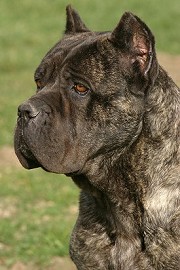
Like most mastiff breeds, a Cane Corso should only be owned by people who are experienced with large breeds with a potentially high risk of aggression.
High-risk breeds are...cool?
Perhaps you secretly think it would be cool to own a breed with a high risk of aggression. But how much experience do you have with such dogs? If you can't handle the dog, how much threat will there be to the public? Do you live in seclusion, or in a close community?
Because honestly, you wouldn't think people could be so clueless, yet (as a trainer) I see it all too often....
Some idiot brings home a male Cane Corso, when he has no experience with large male dogs with a strong working background and high risk of aggression. Said idiot then sticks the dog outside in the yard without supervision, whereupon the dog breaks through the fence and attacks an 80 year old lady walking her toy poodle. Dead and dead.
Irresponsible owners are the main cause of breeds being banned today. If people would stick to breeds they can truly handle without endangering the public, we'd have far fewer dog attacks.
Breeds with a higher risk of aggression toward people
In these dog breeds, a sizable percentage of individuals are dominant, territorial, protective – or may have inherited genes for a sharp or unstable temperament.
Top breeds on my CAUTION list
| Airedale | Dogue de Bordeaux |
| Akita | Fila Brasileiro |
| American Bulldog | German Pinscher |
| Anatolian Shepherd | German Shepherd |
| Australian Cattle Dog | Giant Schnauzer |
| Beauceron | Komondor |
| Belgian Shepherd | Leonberger |
| Bouvier des Flandres | Lhasa Apso |
| Boxer | Neapolitan Mastiff |
| Bullmastiff | Pit Bull Terrier |
| Cane Corso | Presa Canario |
| Chihuahua | Rhodesian Ridgeback |
| Chow Chow | Rottweiler |
| Dobermann | Tibetan Mastiff |
| Dogo Argentino | Tosa Inu |
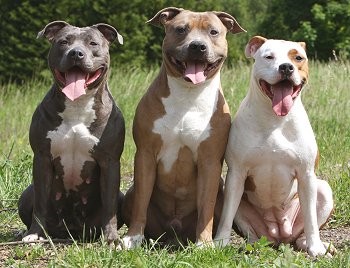
"Pit Bulls" with a high risk of aggression toward people are usually unregistered or crosses/mixes. UKC-registered American Pit Bull Terriers from champion show lines are seldom aggressive toward people.
"What if I want a dog to protect my family/home?"
Some owners want a dog with a high risk of aggression because they think the dog might actively save them by engaging with (and defeating) a bad guy.
That isn't going to happen. Not unless you've trained the dog in practical fighting skills – specialized training that takes a lot of time and effort.
This reality often doesn't go over well with owners who had their heart set on a "protective" dog. Unfortunately they have gross misconceptions about the true protective abilities of dogs. They rhapsodize about how much their pet loves them... "He's so faithful, without a doubt he would lay down his life to protect me."
The reality is very different. Pet dogs are not Lassie or RinTinTin. Despite their owners' fond hopes, pet dogs – of any breed – haven't a clue about how to protect their home or family.
Every day around the world, people are assaulted or robbed, or their homes burgled, while their confused German Shepherd or Rottweiler looks on, wagging his tail uncertainly, or barking frantically but not knowing what else to do.
Protective instincts are NOT the same thing as protective abilities or skills.
How do I know this? Because for many years I trained dogs in protection and police work, and competed in a German sport called schutzhund (German for protection dog). The training is long and rigorous, and for the safety of both owner and public, protection training is paired equally with obedience training for maximum control.
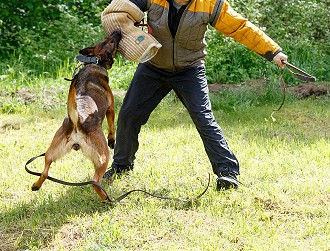
You need a skilled instructor to help your dog learn how to engage effectively with a bad guy.
What are dogs taught during protection training?
HOW to fight a human being: what parts of the anatomy to bite, depending on whether the bad guy is brandishing a weapon or not. How to bite deep, lock down, and hold on, no matter what the bad guy tries to do to get you off.
And confidence, confidence, confidence. Based on months and months of "confronting bad guys" in practice... and coming away victorious.
Without this training, a dog who tries to bite someone will almost certainly bite improperly. He'll snap at an ankle or hand and miss, or he'll get in one quick bite, then dart away – whereupon the enraged criminal will shoot him or knife him or break his ribs with one good kick.
Virtually ALL inexperienced dogs who suddenly find themselves in a real fight with a human being will back down. Now the tables have turned, as the angry bad guy (who was already crazy enough to break into a home with a barking German Shepherd) chases your bewildered, unskilled dog with murderous intent.
Dogs who threaten bad guys, but can't back it up with actual fighting skills, are more often injured or killed, compared to peaceful dogs who leave the bad guys alone. Do you really want your beloved dog to die trying to protect your TV set or the fifty bucks in your wallet?
Legal liabilities of high-risk dogs
I've already explained that dogs with protective instincts but no training can't actually protect you from serious bad guys.
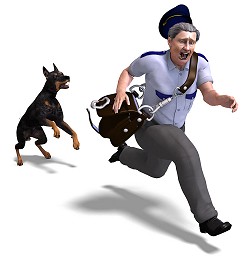
Dogs frequently can't tell who is a threat, as any mailman or delivery driver will tell you.
But what they ARE amazingly good at, judging from all the dog bite cases clogging up the civil courts, is misjudging situations.
Anthropomorphic opinions to the contrary, dogs are pretty poor judges of whether someone is a "bad guy" or not. Most dogs who bite, bite people they know (friends and family) – or the mailman, the meter reader, the UPS guy, the Avon lady, a police officer, or your neighbor.
We live in a litigious society. That means people are quick to sue.
If your dog bites an innocent person, if he even charges toward them and causes them to fall or have a heart attack, you will wind up in court paying medical bills and pain & suffering. Your dog might even be euthanized. Imagine the guilt you'll feel!
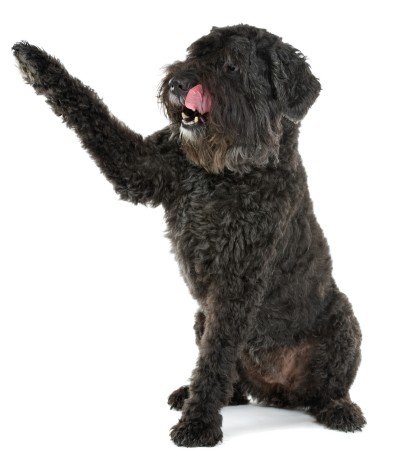
This particular Bouvier des Flandres happens to be friendly and playful with everyone. Most aren't.
If a breed is high risk, are there any non-aggressive individuals in that breed?
Any non-aggressive Dobermans? Chows? Chihuahuas? Bouviers?
Oh yes. Definitely yes. At the beginning of this article, I wrote, "Each dog must be evaluated on its own merits, but breed-wide tendencies should also be considered, since aggression is a trait that is often inherited."
For various genetic reasons, a considerable percentage of dogs within any breed have NOT inherited the breed's typical genes for temperament.
For example, a sizable number of Rotties (Dobes, Boxers, etc.) are big softies who would be very reluctant to harm a human being.
If you find such an individual (or a breeder who produces such pups), you might be able to have your cake and eat it too.
Your dog will LOOK like a Rottweiler (or Doberman, etc.), which should make most bad guys seek easier pickings.
But your friendly dog wouldn't threaten anyone, so you won't have to worry about anyone's safety. Or lawsuits.
What's the downside? Well, how can you be sure you really DID find one of the a typical Belgian Shepherds? What if you unknowingly picked one of the typical ones?
Here's a related issue.....
Banned/restricted breeds
In response to an increasing number of dog bites, communities around the world have enacted laws against the ownership of certain breeds.
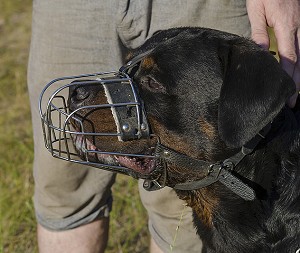
In some areas, a muzzle might be required if you own certain breeds.
A breed might be banned outright. Or you may be required to muzzle him in public. Or to obtain extra liability insurance, or to pay fees to register him in a Dangerous Dogs database.
In addition, some insurance companies have a list of restricted breeds. Bring home one of these breeds and your rates might be raised, or your homeowner's policy revoked.
Even if your insurance is not revoked, it might refuse to cover a dog-bite incident. Then you'd be responsible for paying the medical bills, pain and suffering, and other damages.
Banned/restricted lists are always headed by Pit Bulls and pit bull "types" (breeds and crosses that resemble pit bulls). Many lists also include the Rottweiler, Akita, Cane Corso, Presa Canario, Chow, German Shepherd, and others.
So if you're considering a medium, large, or giant breed with a high risk of aggression toward people, you might want to call your homeowner's insurance company and local government offices and ask about any breed restrictions.
Keep in mind that even if a breed doesn't yet appear on their list, it might in the future. Some communities and homeowners associations already have restrictions on ALL dogs over 100 pounds.
Summary
Most owners do best with a dog that doesn't have a high risk of aggression toward people. This might be a purebred, crossbreed, or mixed breed.
Don't worry that your lower-aggression dog won't be a good watchdog. Every breed can (and usually will) bark or offer some kind of alerting behavior when he sees or hears something unusual near his property.
Even the barking of a friendly or inoffensive dog is all the "watching" that most families need. Barking draws attention, so the majority of burglars will shy away from homes in which any dog is barking.
My best-selling books – now available FREE on my website
 Respect Training For Puppies: 30 seconds to a calm, polite, well-behaved puppy is for puppies 2 to 18 months old. Your puppy will learn the 21 skills that all family dogs need to know. Click here to read for free.
Respect Training For Puppies: 30 seconds to a calm, polite, well-behaved puppy is for puppies 2 to 18 months old. Your puppy will learn the 21 skills that all family dogs need to know. Click here to read for free. Teach Your Dog 100 English Words is a unique Vocabulary and Respect Training Program that will teach your adult dog to listen to you and do what you say. Click here to read for free.
Teach Your Dog 100 English Words is a unique Vocabulary and Respect Training Program that will teach your adult dog to listen to you and do what you say. Click here to read for free. 11 Things You Must Do Right To Keep Your Dog Healthy and Happy helps your dog live a longer, healthier life. Get my honest advice about all 11 Things before you bring home your new puppy, because some mistakes with early health care cannot be undone. Click here to read for free.
11 Things You Must Do Right To Keep Your Dog Healthy and Happy helps your dog live a longer, healthier life. Get my honest advice about all 11 Things before you bring home your new puppy, because some mistakes with early health care cannot be undone. Click here to read for free.
